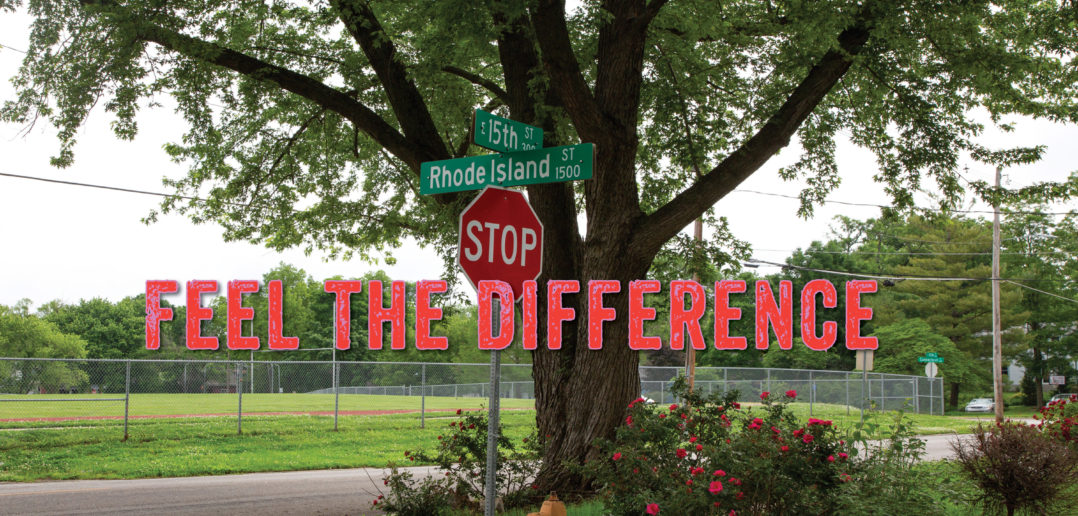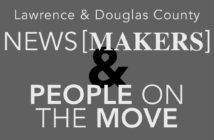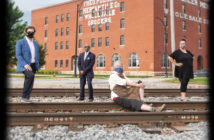| story by | |
| photos by | Steven Hertzog |
East Lawrence is not just one side of a larger town but an area with a distinctive culture uniquely its own.
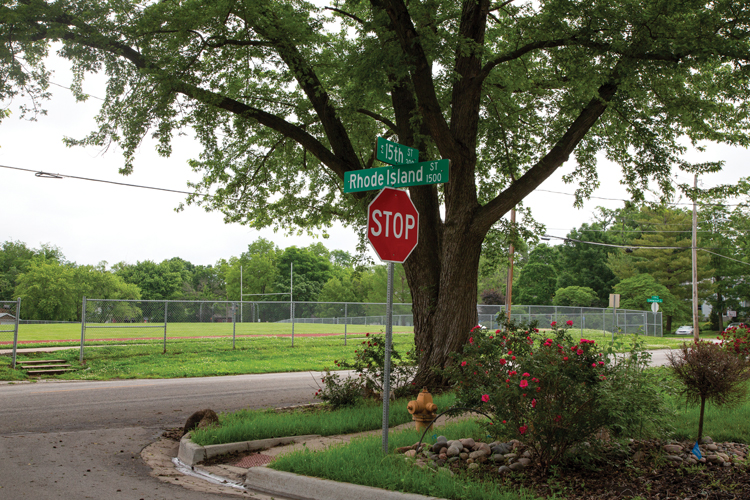
Eastern Lawrence
First, we must define what East Lawrence is and what it is not.
“East Lawrence” is distinct from “east” or “eastern Lawrence.” East Lawrence is a neighborhood, not the side of town opposite of West Lawrence, as many may already know. The East Lawrence Neighborhood Association (ELNA) describes the neighborhood boundaries in its bylaws, codified by the City. It is “bounded on the North by the Kaw River, on the South by 15th Street and on the East by the Railroad Tracks. The West boundaries are as follows: Rhode Island Street between the river and 9th Street; the alley behind New Hampshire Street between 9th and 11th Streets; Rhode Island Street between 11th and South Park Streets; and Massachusetts between South Park Street and 15th Street.”
These are the physical and technical boundaries of “East Lawrence.” But East Lawrence is more than just its boundaries. Like every vibrant neighborhood, East Lawrence is a mood, a feeling and an idea.
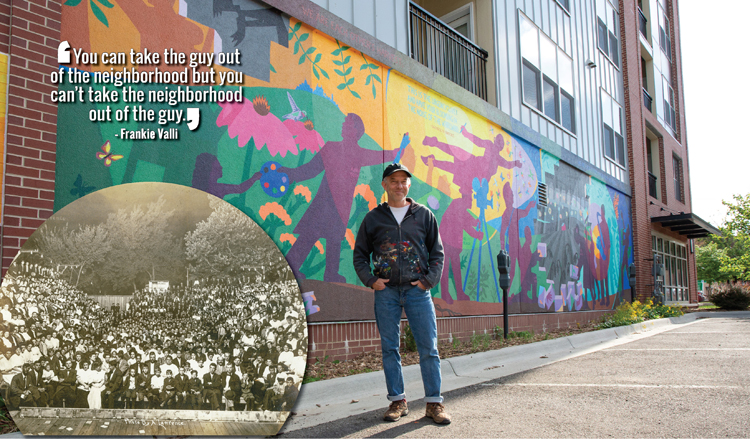
Dave Loewenstein stands in front of one of his murals at 834 New Hampshire which is known today as the Lawrence Farmers Market. On that same property from 1908-1912 was an outdoor summer theater called The Airdome Fair Theater. Douglas County Historical Society, Watkins Museum of History.
“East Lawrence is two things I think,” explains Dave Loewenstein, ELNA board member. “One is it’s a neighborhood, and that has actual boundaries … but there’s another East Lawrence, which is an idea.”
This is where the identity, the culture formed by and about East Lawrence, blurs the physical boundaries. Predominantly created by how the neighborhood chooses to officially (and unofficially) represent itself in the public domain and how outsiders’ perceive and interpret that representation, East Lawrence identity and culture have found allies in residents of adjacent neighborhoods, so much so that they consider themselves a part of East Lawrence.
The idea “changes depending on who you talk to,” Loewenstein continues. But essentially, East Lawrence is “where people look out for each other, and they support each other. And I think that even more fundamentally, they need each other. We need each other to help on each other’s houses. We need each other to advocate at City Hall. We need each other because we want to be social and meet people. We need each other for work. We need each other for food sometimes. It’s always been a place that produced food, whether it was the canning factories or the community gardens and Just Food of today.”
Former resident of the 1300 block of Rhode Island Street and local principle blacksmith Kate Dinneen explains, “It is an honestly strong neighborhood, and that attracts a lot of people … you can be whoever you want to be there. You can be yourself. Or you can be something that you’ve created.”
These two notions of support, neighbors supporting neighbors and free self-expression, are qualities that many neighborhoods certainly embrace, perhaps a little differently. The East Lawrence “idea” creates a kind of kinship with the people and businesses of adjacent Brook Creek, Barker and even Downtown neighborhoods.
For example, there is recognition of Cottin’s Hardware and Rental, which is distinctly and officially in the Barker neighborhood, as part of East Lawrence in spirit if not geographically. But “we feel Cottin’s,” says Loewenstein, meaning there is an alignment of values between Cottin’s and East Lawrence.
The way in which East Lawrence “feels” another institution, another business, seems contingent upon that entity’s alignment with the values of East Lawrence, what it is it represents. It’s easy to recognize that hard work, locally owned and supported organizations, and care for the city and the people in it are predominant.
Appealing but Complex
Dinneen performs her rugged craft, as do others, at “Cussed Wild,” a forge and studio space at 721 E. 9th St. “[‘Cussed’ is] where the dirty artists are—the blacksmiths and the stone carvers—those of us who make noise and dust,” she says.
A significant portion of the Lawrence Cultural District, established by the City of Lawrence Cultural District Task Force in 2013, covers much of East Lawrence. With churches, galleries, historic buildings and architecture, one might not be surprised that it is a place full of activities, beautiful sights and public places to gather together—when there’s not a global COVID-19 pandemic.
With such qualities, East Lawrence certainly is attractive to many. However, these alluring qualities have brought with them a number of influences East Lawrence neighbors are wary of embracing, as they could potentially change its fundamental character.
East Lawrence Improvement Association in the 1970s supported the Haskell Loop proposal. The proposal intended to build a high-traffic roadway through East Lawrence, from Haskell Avenue to downtown, threatening the destruction of 40 homes and a stadium. The neighborhood organized, formalized, spoke up and ultimately defeated the proposition. From there, ELNA came into being, even challenging a later proposal for yet another trafficway.
“East Lawrence was, figuratively and literally, looked down upon by the city for decades if not a century,” Loewenstein says. The Haskell Loop and later Eastern Parkway proposals insinuated “many people just wanted to get around East Lawrence on their way to downtown.”
Even more recently, “a community art and streetscape” project called the 9th St. Corridor Project was a potential change to the neighborhood that worried many East Lawrence residents. The impulse to resist such impositions is what Loewenstein calls “historical memory.”
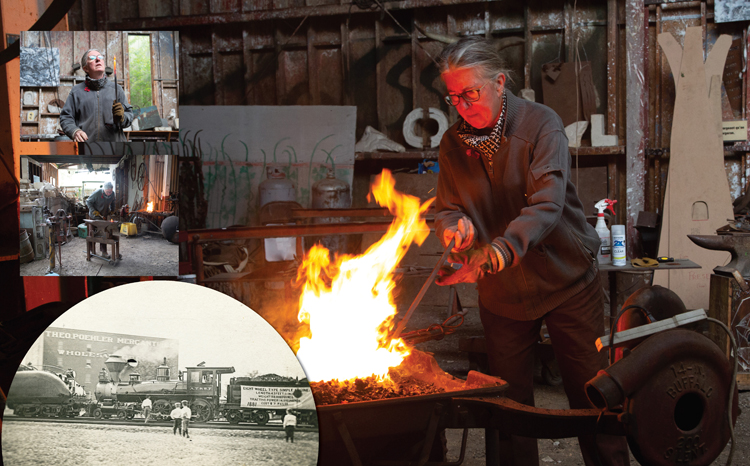
Blacksmith Artist Kate Dinneen works in her studio in East Lawrence. A smally locomotive on track near Theo. Poehler Mercantile Wholesale building. Attached banner reads, “Eight wheel type engine…1881”. Douglas County Historical Society, Watkins Museum of History.
Defending Its Character
Resilience and longevity are values of East Lawrence, as well.
The future of East Lawrence and what its future might hold has been a discussion among nonresidents for some time, and residents often feel they aren’t heard and are often not even included in the conversations about what can and should happen in their backyards. Dinneen, who has long-served as an arts educator and community activist, explains: “They have been trod upon.”
East Lawrence residents’ “ability to continue to shape organically the place that they live could be taken out of their hands pretty quickly,” Loewenstein says. “And this is not all bad, but I’m really aware of how those impacts could have larger consequences than they originally set out to have.” It is with this care and concern that the passion of ELNA and the neighborhood at large may be perceived negatively by those who aren’t as invested in the character and people of East Lawrence.
Development and business in particular could shape East Lawrence in many significant ways. As with all the potential changes—residents, businesses—it’s a complicated bag of potential. For instance, relative newcomers Bon Bon and Lawrence Beer Co. ping Loewenstein’s radar and likely many others’.
“I think Bon Bon’s great,” he says. “I love how they rehabbed that building. I think it’s a really nice business.” Then he weighs the possible unforeseen effects. “I think there’s a lot of East Lawrence folks who can’t afford it or really can’t afford it very often. And a large number of folks who, it’s not their jam. And I think that’s OK, too. It’s just that, if you start to have one, two, three, four, five—you know, how many of those do you have before the culture of the place really changes?”
It’s this unknown impact, this potential change of character that creates an environment that can be both positive and negative. “Folks who come in to East Lawrence,” Dinneen says, “want to enjoy the fun thing that drew them there but also to change it to fit them because of what makes them comfortable. So there’s this constant tension. And I think a lot of times, tension is very attractive.”
As with any type of tension, people experience it differently, hence the varied responses to initiatives from the residents of East Lawrence and ELNA. “People think of [ELNA] as a monolith,” Loewenstein says, “but it is not.” The board of ELNA is populated by people whose ideas and opinions differ, often greatly. All come to the table with a passion for East Lawrence, yet the tension creates fear and concern for some, opportunity and excitement about possibilities for others.
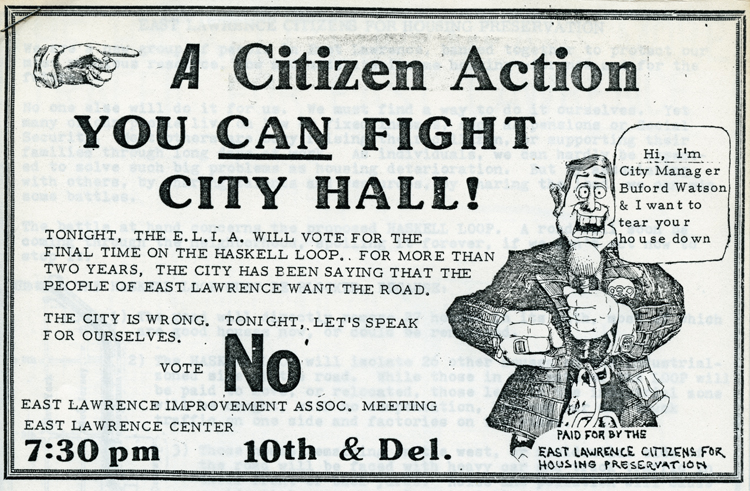
A Citizen Action flyer for an East Lawrence Improvement Association meeting. Douglas County Historical Society, Watkins Museum of History.
This kind of tension is terrific for the artists who work there. Even they recognize the influences and neighborhood responses that create this tension are real for their neighbors. “We can be noisy there, we can be dirty there,” Dinneen says. “We’re right next to the railroad tracks, but if too many people move in and start complaining about what we’re doing, we’re not going to have a place to exist. Art like that is not going to be able to happen.”
The bigger concern, of course, is the impact on the pocketbooks of residents, current and potential. “How does that impact the folks that have been living there to stay in their homes?” Loewenstein says. “And whether or not younger families or individuals can afford to live there? It’s something we’re facing more now than we ever did.” An influx of development, business and even would-be residents could have an effect on people’s ability to live in East Lawrence because of an increase in property values and therefore taxes.
This adds yet another source of existential tension: the thriving, exciting East Lawrence that draws businesses and people to it is also what could potentially and unintentionally change what the neighborhood is and its values. Whether person or business or development, you can be who you want to be unless it raises property taxes. “That’s the tension of East Lawrence,” Dinneen says.
“Even though East Lawrence has a reputation of being cranky or belligerent or arguing just for the sake of arguing, there’s also a lot of caring,” she adds.
The Silver Lining
Neighborhoods in cities such as Lawrence embrace and promote their character and one-of-a-kind qualities so as to distinguish and make a place for themselves. As new opportunities develop, the question becomes how does a neighborhood keep its identity and be “shaped organically” with so much interest and so much influence pervading from without?
East Lawrence is clearly distinct from other neighborhoods and continues to draw attention and interest from people and businesses similarly passionate about all that it has to offer. Because of, or in spite of, the “tension,” it continues to be a focal point for any and all who are excited about its essential character and what it could be.
This is what makes East Lawrence integral to Lawrence as a whole, vital to our culture and arts scene, and a wonderful place to live.

